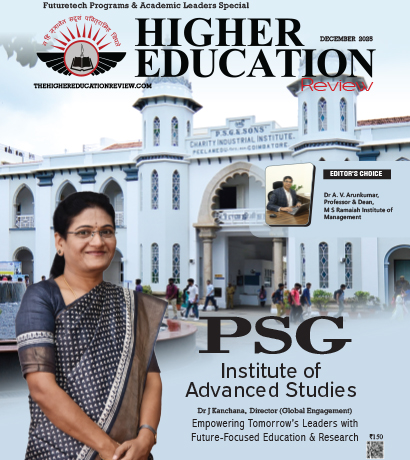Integrating Disruptive Technologies Into Higher Education
 Anupama Rajesh, Professor, Amity International Business School, Amity University, shared her insights on the need to embed disruptive technologies in higher education. She highlights how AI, blockchain, IoT, biotechnology, and quantum computing are transforming sectors and society. The incorporation of these technologies creates critical thinking, interdisciplinary collaboration, greater focus on practical problem solving, and ethical considerations, which would prepare students for careers related to technology.
Anupama Rajesh, Professor, Amity International Business School, Amity University, shared her insights on the need to embed disruptive technologies in higher education. She highlights how AI, blockchain, IoT, biotechnology, and quantum computing are transforming sectors and society. The incorporation of these technologies creates critical thinking, interdisciplinary collaboration, greater focus on practical problem solving, and ethical considerations, which would prepare students for careers related to technology.
The 21st century has ushered in an era of rapid technological transformation, reshaping industries, economies, and societies globally. In this dynamic landscape, higher education institutions face the challenge of preparing students not merely for existing careers but for a future characterized by constant innovation and disruption. Disruptive technologies -those innovations that fundamentally alter traditional practices, business models, and social behaviors are at the forefront of this transformation. Examples include artificial intelligence (AI), blockchain, Internet of Things (IoT), biotechnology, quantum computing, and advanced robotics. Incorporating the study of these technologies into higher education curricula is critical for equipping students with the technical expertise, analytical skills, ethical understanding, and adaptability required to thrive in a technology-driven world.
Incremental Innovations for new paradigms
Disruptive technologies differ from incremental innovations in that they create entirely new paradigms, redefine industry standards, and often challenge long-standing societal norms. Their defining characteristics include radical innovation, which introduces breakthroughs that reshape entire sectors, and market impact, which disrupts conventional business models while creating new economic opportunities. They also exert societal influence by changing how individuals interact with technology and evolve rapidly, demanding continuous learning and adaptation. Examples such as AI and machine learning, blockchain, IoT, biotechnology, and quantum computing illustrate their transformative potential. By understanding these technologies, students gain valuable insights into their impact and learn to anticipate their effects across multiple domains.
Future-ready Workforce
Integrating disruptive technologies into higher education is essential for several reasons. First, it prepares a future-ready workforce by equipping students with in-demand technical skills, improving employability, and enabling graduates to thrive in sectors such as finance, healthcare, manufacturing, and IT. Exposure to real-world applications fosters practical problem-solving abilities that are immediately useful in professional environments.
Also Read: How Global Research Collaborations Shape Careers
Fostering innovation and entrepreneurship
Second, it fosters innovation and entrepreneurship by encouraging creativity and enabling students to identify market opportunities, support startups, and engage in applied research that can lead to commercial and societal benefits. Third, it promotes critical thinking and ethical decision-making, as many disruptive technologies raise complex ethical, societal, and regulatory issues.
By analyzing these aspects, students become more responsible professionals capable of influencing policy and practice. Fourth, it enhances research capabilities by allowing students to engage in cutting-edge, interdisciplinary initiatives that combine technology with business, ethics, and social sciences, thereby driving knowledge creation, economic growth, and societal advancement. Finally, it ensures societal adaptability by preparing students to navigate global trends, manage technological challenges, and embrace lifelong learning and adaptability in uncertain times.
Curriculum development with courses in AI, blockchain, IoT, robotics, biotechnology,
To harness these benefits, higher education institutions can adopt several strategies for effective integration. Curriculum development is key, with specialized courses in AI, blockchain, IoT, robotics, biotechnology, and other emerging fields, alongside project-based learning and case studies that emphasize real-world problem-solving. An interdisciplinary approach is also important, combining technology with ethics, business, law, and social sciences, and promoting systems thinking to help students understand interconnected impacts. Industry collaboration further strengthens education through partnerships with technology firms, internships, mentorship programs, and cooperative education models that blend academic and professional experiences. Expanding research opportunities by supporting student-led projects, hackathons, and faculty-student collaborations enhances innovation and knowledge creation. Equally vital is faculty development, ensuring that educators remain up-to-date with technological advancements, engage in interdisciplinary research, and embrace continuous professional growth to enhance teaching effectiveness.
However, integrating disruptive technologies into education also presents challenges. Rapid technological change means curricula can quickly become outdated, necessitating continuous updates and adaptive learning models. Limited resources, such as the high-cost of advanced labs and tools, can be mitigated through online platforms, open-source tools, and partnerships with industry. Ethical and societal concerns must be addressed by embedding studies of ethics, policy, and social impact into all programs. Furthermore, not all students enter with strong technical foundations, making it necessary to offer preparatory courses, workshops, and mentorship to build competency and confidence.
In conclusion, the integration of disruptive technology studies in higher education is no longer optional but a strategic imperative. Preparing students to navigate, shape, and innovate within rapidly changing technological landscapes is central to academic and societal progress. By embedding these studies into curricula, universities cultivate graduates who are not only proficient in emerging technologies but also capable of ethical decision-making, innovation, and lifelong adaptability. Such an approach ensures that higher education continues to drive economic development, societal advancement, and global competitiveness in an era defined by technological disruption.
About the Author
Anupama Rajesh possesses a Ph.D. in Technology in Education along with multiple postgraduate degrees in IT, Management, and Education, after training in Case Writing at INSEAD in Paris, France. Prof. Rajesh has been involved in teaching for over 25 years and has published more than 100 research papers, along with 10 books, and several case studies while also leading international research and training activities.

